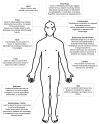Altered mental status in older patients in the emergency department
- PMID: 23177603
- PMCID: PMC3614410
- DOI: 10.1016/j.cger.2012.09.005
Altered mental status in older patients in the emergency department
Abstract
Altered mental status is a common chief compliant among older patients in the emergency department (ED). Acute changes in mental status are more concerning and are usually secondary to delirium, stupor, and coma. Although stupor and coma are easily identifiable, the clinical presentation of delirium can be subtle and is often missed without actively screening for it. For patients with acute changes in mental status the ED evaluation should focus on searching for the underlying etiology. Infection is one of the most common precipitants of delirium, but multiple causes may exist concurrently.
Copyright © 2013 Elsevier Inc. All rights reserved.
Figures




References
-
- Morandi A, Pandharipande P, Trabucchi M, et al. Understanding international differences in terminology for delirium and other types of acute brain dysfunction in critically ill patients. Intensive Care Med. 2008;34(10):1907–1915. - PubMed
-
- Clarfield AM. The decreasing prevalence of reversible dementias: an updated meta-analysis. Arch Intern Med. 2003;163(18):2219–2229. - PubMed
-
- Schuur JD, Venkatesh AK. The growing role of emergency departments in hospital admissions. N Engl J Med. 2012;367(5):391–393. - PubMed
-
- Niska R, Bhuiya F, Xu J. National Hospital Ambulatory Medical Care Survey: 2007 emergency department summary. Natl Health Stat Report. 2010;(26):1–31. - PubMed
-
- He W, Sengupta M, Velkoff VA, DeBarros KA. US Census Bureau, Current Population Reports, P23–209, 65+ in the United States: 2005. U.S. Government Printing Office; 2005.
Publication types
MeSH terms
Grants and funding
LinkOut - more resources
Full Text Sources
Other Literature Sources
Medical

